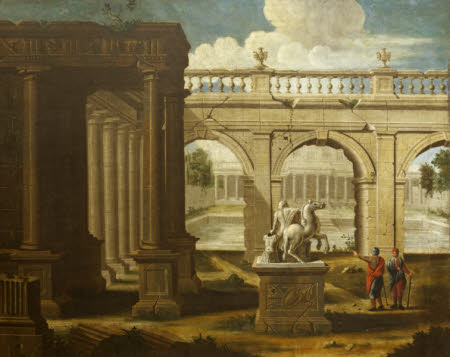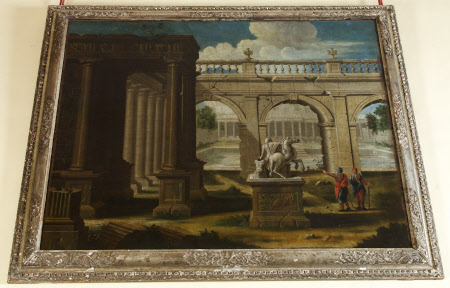A Capriccio of Classical Architecture and Sculpture, with Two Figures
after Thomas Blanchet (Paris 1614 - Lyon 1689)
Category
Art / Oil paintings
Date
1600 - 1699
Materials
Oil on canvas (?)
Measurements
1244 x 990 mm
Place of origin
France
Order this imageCollection
Lacock, Wiltshire
NT 996280
Caption
A Capriccio is a made-up view, sometimes including known buildings. Here, the statue in the centre foreground, is derived from one of the Dioscuri (Horse Tamers) on the Quirinal in Rome. Blanchet started his career studying sculpture, but soon moved to painting. He stayed in Rome from around 1645 until 1653, working with artists in the circle of Nicholas Poussin. He made engravings of various views, in particular of ancient sites.
Summary
Oil painting on canvas, A Capriccio of Classical Architecture and Sculpture, with Two Figures, after Thomas Blanchet (Paris 1614- Lyon 1689), 17th century.
Full description
A capriccio of Classical ruins, with a portico-type structure to the left, of the Doric order; an arcade surmounted by balustrade in the near background; an ornamental pool and colonnade in the far background; and a statue in the centre foreground, derived from one of the Dioscuri on the Quirinal, indicated by one traveller to another. The picture is in the manner of an artist such as Jean Lemaire, but not of a standard to be attributed to a specific painter (in particular the clumsy execution of the figures and the statue of the horse-tamer). The composition does not appear to have been derived from any particular work by Lemaire (see Maurizio Fagiolo dell’Arco, Jean Lemaire pittore ‘antiquario’, Rome, 1996). Although he sometimes depicted the Horse-Tamers, he did so from behind.
Provenance
given by Matilda Theresa Talbot (formerly Gilchrist-Clark) (1871 – 1958), who gave the Abbey, the village of Lacock and the rest of the estate to the National Trust in 1944, along with 96 of the family portraits and other pictures, in 1948
Credit line
Lacock Abbey, The Talbot Collection (National Trust)
Makers and roles
after Thomas Blanchet (Paris 1614 - Lyon 1689), artist manner of Jean Lemaire (Seine-et-Marne 1597 - Gaillon 1659) , artist

